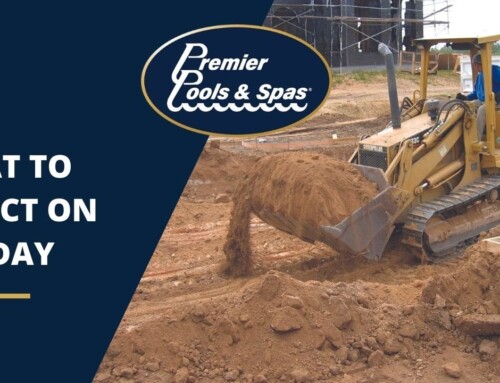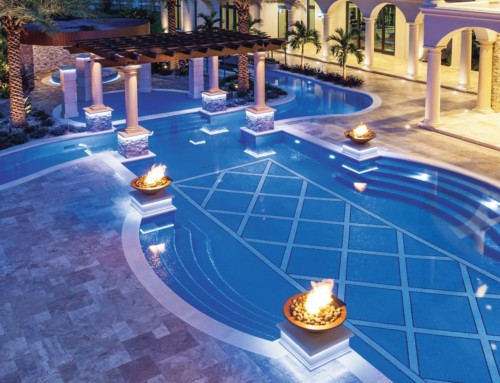One of the many decisions you will make as a new swimming pool owner is what kind of pool decking materials to utilize in the area surrounding your pool. If you’ve chosen a fiberglass pool, you may also consider the addition of coping, which creates a transition between the pool and pool deck.
First, let’s look at the pros and cons of different pool decking options. The most sought-after option is concrete decking.

Concrete Pool Decking
Concrete Pool Decking
When thinking of concrete, most of us probably think of the dull grey blocks often seen at construction sites and industrial parks. However, concrete is far more flexible.
Concrete is available in a wide array of colors and can be textured to create a unique appearance.
Concrete is also easy to clean and has a lengthy lifespan.
Broom Finished Concrete
By far the most popular and economic option, broom finished concrete decking is created by pouring concrete, then brushing it with horse-hair brooms to create a slightly textured surface. Brushing the concrete not only gives it a textured look, but it is also an easy way to provide traction, which helps prevent slips and falls.
Exposed Aggregate Concrete
With this option, tiny stones or pebbles are introduced into the concrete mix. The aggregate comes in a variety of colors and sizes and adds texture to the surface. You can add raw or machine-polished aggregate. Machine polished aggregate is gentler on bare feet.

Stamped Concrete Pool Decking
Stamps and Stencils for Concrete Pool Decking
Stamped concrete is another in-demand method for producing decorative concrete decking.
Using pattern molds, your builder can stamp impressions into wet concrete to make its surface visually mimic the shape of different materials, such as tile, brick, or stone. And like the genuine material, the stamp forms can create a large variety of patterns.
Stenciling takes things one step further. Intricate designs are constructed with custom-made stencils. The sky’s the limit on colors and motif.
Stenciling is a delicate process using time and labor, so it costs more to implement.
While the benefits and low cost of concrete make it an attractive option, concrete does not come without a few disadvantages. Concrete decking can crack, especially if it’s not cured correctly.
Pool Pavers

Pool Decking with Pavers
Pool pavers are precast sections of stone, clay, or concrete. Pavers are created by mixing in aggregate and color, then creating individual, brick-like pieces. The pavers are laid out in patterns around your pool area.
One of the many benefits of utilizing pavers is that there is no need to wait for them to dry, as you would with poured concrete.
Pool pavers can be arranged to compliment many types of design schemes because of their large variety of shapes, colors and sizes.
Pavers can be replaced easily. You can remove and replace single pavers without a lot of effort. However, pavers require a strong base, and many contractors who do not specialize in installing pavers fail to provide the strong base pavers need. Some contractors lay a scarce amount of sand under the pavers which can cause the pavers to sink.
Natural Stone/Travertine Decking
Stunning travertine is one of the most commonly used natural stones utilized in homes today. But travertine decking isn’t just about visual charm, it is also slip-proof, and stays cooler than other decking materials.
One of the cons of travertine is its porous nature, which makes it easier to absorb water. While this offers a benefit in hot weather, it can be a disadvantage if your pool decking is near loose soil, as dirt can get trapped in the pores.
Another design advantage of using travertine for your pool deck: pool coping. You can match the edge of the pool with the rest of the patio by coping it with the same travertine blend.
Speaking of coping…

Swimming Pool Coping
Fiberglass Pool Coping
If you’re planning on a fiberglass pool, you’ll need to decide whether or not to leave the edge of the fiberglass exposed or utilizing coping. Leaving the edge exposed should be your last choice. An exposed fiberglass pool edge is subject to sun fade, and if you pour concrete decking up to the edge of the fiberglass pool, you risk cracking and chipping.
Coping also adds that special finishing touch to the edge of your pool. It creates definition between your pool and pool decking.

Cantilevered Coping
Cantilevered Concrete Coping
A frequent choice for coping around fiberglass pools is cantilevered concrete coping.
Similar to concrete decking, cantilevered concrete coping is unique in that it is manufactured with one continuous pour.
Cantilevered concrete edging adds a beautiful finish to your fiberglass pool. Much like concrete decking, it comes in a variety of colors and textures.
Cantilevered concrete coping is affordable, and due to its single-piece construction, it’s less likely to move or shift over time. However, much like its decking counterpart, concrete coping can succumb to cracks if not managed correctly.
Precast Paver Coping
Paver coping is precast into shapes, then installed on-site. Just like decking pavers, they are simple to replace if damaged.
Pavers can be laid on a mortar bed or bonded to the pool shell and concrete collar around the pool with specialized construction adhesive.
Pavers are a little more expensive than poured and precast concrete, but many pool owners find that their value far outweighs the expense.
Natural Stone/Travertine Coping

Travertine Coping
Natural stone coping can be visually stunning. Among natural materials, travertine is a favorite because it stays cooler in the sun and is naturally slip-resistant.
Some natural stone is a durable choice, able to withstand ongoing exposure to chlorine, while some types of stone are less durable and require more maintenance in a swimming pool environment.
Natural stone is the most expensive choice for pool coping, but many pool owners find the cost valid.
When selecting a coping material, note that you can select a different substance than the decking itself. If you choose concrete decking, for example, you may complement the concrete with travertine coping.
Before you choose the material for your pool deck and coping you need to consider some major criteria – durability, safety, comfort, and esthetics. Remember that the material should work harmoniously with your backyard and pool design.

Paver Decking w/ Flagstone Coping



